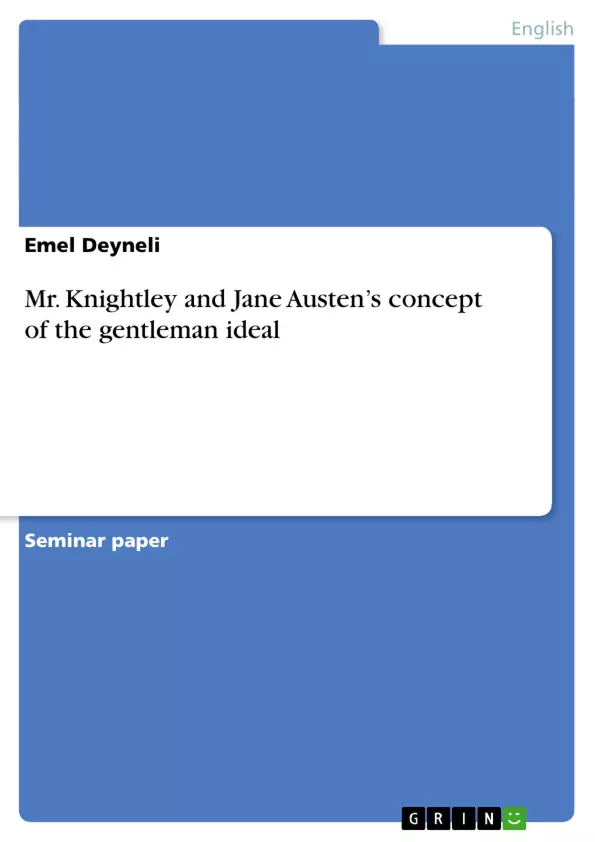Jane Austen was born on 16 December 1775 at Steventon, near Basingstoke, the seventh child of the rector of the parish. She began to write stories wen she was a girl, but only four of her novels were published during her lifetime.1 Among them was Emma published in the year 1816. Although Jane Austen chooses women as her heroines, there are also different types of men represented. They extend from the villain to the polite gentleman. The following term paper will try to examine Jane Austen’s gentleman ideal in her novel Emma with a representative English gentleman. This is Mr. George Knightley. The virtues that Emma praises in Robert Martin’s letter are all those which can be associated with the traditional age of chivalry: There were merely no grammatical errors, but as a composition it would not have disgraced a gentleman; the language, though plain, was strong and unaffected, and the sentiments it conveyed very much to the credit of the writer. It was short, but expressed good sense, warm attachment, liberality, propriety, even delicacy of feeling.2
The name „Knightley“ reveals already parts of the meaning. It contains the word „knight“ who used to play an important role in Chaucer’s poetry. In Chaucer’s knight and Squire, for instance, is the knightly honour represented and Mr.Knightley embodies this. However, Jane Austen takes Chaucer’s knight with his characteristics as a point of departure but she modernizes this image. While honourable young men dedicated themselves to courtly love, they do not so in Jane Austen’s novels. Mr. Knightley as the representative English gentleman in the novel Emme will be looked at and analysed throughout the novel. The main emphasis will be in his development from the beginning till the end and the characteristics which make him a gentleman.
Inhaltsverzeichnis (Table of Contents)
- I. The development of the gentleman ideal from Chaucer to Jane Austen
- II. The embodiment of the gentleman ideal in Mr. Knightley
- 1. Mr. Knightley and Emma
- 2. Mr. Knightley's social behaviour and attitude
- 3. Mr. Knightley vs. Frank Churchill
- III. Conclusion
Zielsetzung und Themenschwerpunkte (Objectives and Key Themes)
This term paper aims to explore Jane Austen's concept of the gentleman ideal in her novel Emma, using Mr. George Knightley as a representative example of an English gentleman. The paper will analyze Mr. Knightley's character development throughout the novel and identify the characteristics that make him a gentleman.
- The development of the gentleman ideal from Chaucer to Jane Austen
- Mr. Knightley as the embodiment of the gentleman ideal in Emma
- The virtues and characteristics of a gentleman in Jane Austen's time
- A comparison of Mr. Knightley with other male characters in the novel
- The role of social behavior and attitude in defining a gentleman
Zusammenfassung der Kapitel (Chapter Summaries)
Chapter I examines the evolution of the gentleman ideal from Chaucer's portrayal of the knight in "The Canterbury Tales" to the 17th and 18th centuries, including the influence of Castiglione's "The Book of the Courtier" and Lord Chesterfield's letters. Chapter II focuses on Mr. Knightley's character in Emma, analyzing his relationship with Emma Woodhouse, his social behavior and attitude, and his contrast with other male characters, particularly Frank Churchill.
Schlüsselwörter (Keywords)
This paper centers on the gentleman ideal in Jane Austen's Emma, focusing on the character of Mr. Knightley. Key themes include the evolution of the gentleman ideal, the characteristics of a gentleman, and the role of social behavior and attitude in defining a gentleman. The paper also explores the contrasts between different types of men represented in the novel, particularly the distinction between Mr. Knightley and Frank Churchill.
- Quote paper
- Emel Deyneli (Author), 2002, Mr. Knightley and Jane Austen’s concept of the gentleman ideal, Munich, GRIN Verlag, https://www.grin.com/document/10867



